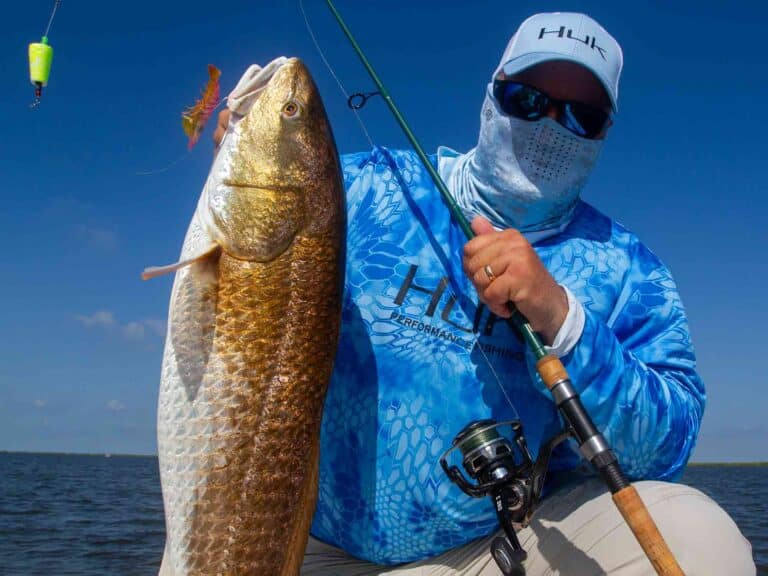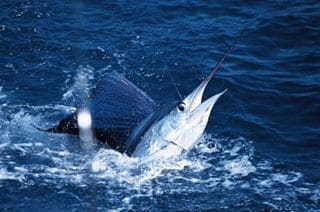
| Each sailfish at Isla Mujeres is that much sweeter for the traditional methods required to catch them. At this hot spot, all anglers must bait and hook their own fish. |
Isla Mujeres, a small island off the east coast of Mexico, has generated big headlines in recent years, due to some incredible sailfish catches that have occurred there. Professional crews from the U.S. have racked up amazing catches, with one boat releasing over 100 fish in a single day last year. Where else can you hope to encounter Atlantic sailfish in numbers like that? But while these spectacular fishing days can and do occur, they tell you very little about what Isla Mujeres (pronounced “ees-la moo-hay-rez”) is really all about. The frantic pace of one crew trying to outdo the next in releases is actually the antithesis of what most fishermen encounter here. For most people, the island is a laid-back, friendly, beautiful and, most importantly, fun place to visit.
My family and I flew to Mexico last spring for a fishing vacation on Isla Mujeres. Our charter skippers were two of the island’s best: Captain Anthony Mendillo, who operates two boats out of the Club de Yates marina, and longtime friend Captain Karl Anderson, who skippers the Brier Patch, a vintage 45-foot Rybovich.
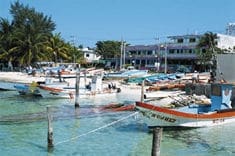
Though situated within easy striking distance of Cancun’s raucous nightlife, Isla manages to maintain a rustic, laid-back atmosphere.|
Island Rules
Isla Mujeres, also known simply as “Isla,” is unique in that a group of concerned fishermen, led by Enrique Lima Zuna, owner of the marina and Anthony’s father-in-law, got together many years ago and crafted some conservative rules under which the sailfish fishery would be managed. They banned the use of live bait and casting tackle, opting instead to keep the fishery traditional. As a result, everyone uses 20-pound-test, conventional trolling gear and dead bait only. It’s like Palm Beach in the 1950s, and to score here you’ve got to hook your own fish.
“It’s a code of conduct that everyone agrees to,” Mendillo explained. “There’s no casting, no pitching baits, no backing into pods of sailfish, and no live bait. Consequently, Isla is a great place to practice your trolling skills and learn to hook your own fish.”
Because of this philosophy, sailfishing at Isla is a labor-intensive business. Mates arrive early at the docks to rig ballyhoo for hook baits, and both ballyhoo and mullet for teaser baits. The teasers are huge, weighted umbrella rigs called dredges, and are designed to imitate a school of baitfish swimming behind and beneath the boat. It’s not uncommon for the mates to rig 200 or more baits a day.
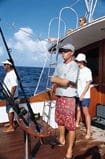
The more eyes the better. The vigilant crew of the Brier Patch scans the spread for activity.|
We were pleasantly surprised to find that fishing usually begins around 10 a.m., which gave us time to enjoy a hearty breakfast at one of the island’s many fine restaurants. With everyone fortified for a big day of fishing, we hopped aboard the Brier Patch and began running east towards the edge of the reef. The sailfish congregate along a bank that runs from just east of Isla Mujeres to a point offshore of the northern tip of the Merida peninsula, a distance of 50 miles.
As we headed into deeper water, Karl studied his fishfinder screen intently, looking for pods of bait. The reef off Isla holds huge schools of baitfish, including cigar minnows and sardines. Find the bait and you find the sailfish-theoretically, at least. Once you locate a big pod, the strategy is to work the baits back and forth across it, hoping to entice a strike.
The sails and the bait are most often found in 85 to 150 feet of water, ten miles or more east of Isla. As we approached the hot zone, the skies filled with frigate birds. I had seen big flocks of these birds in Costa Rica, but nothing compared to the scene off Isla. Hundreds of frigates hovered, wheeled and dove around us.
Dredges Down!
It didn’t take long to locate a giant pod of bait on the sounder, and the mates quickly deployed two dredges-one rigged with ballyhoo and the other with mullet. Both Anthony and Karl say the dredges must run deep, below the boat’s prop wash, in order to be effective. After the dredges are in place, the hook baits go out. These are simple, naked ballyhoo run on 50- or 60-pound-test leaders and rigged with 6/0 Mustad 9975 or equivalent hooks.
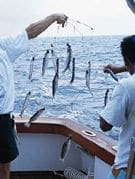
Though a typical day off Isla generally sees multiple shots at sails, the number of fish leadered by the mate will depend on the anglers’ skill at mastering the bait-and-switch. Weighted “dredge” teasers, which mimic pods of baitfish, are used by many crews to coax sailfish to the surface.|
As we settled into a trolling pattern, Karl explained that fishing had been a little slow lately, and that we should probably expect only seven or eight shots. Only seven or eight? Everywhere else I’ve fished, that would be considered a great day, but it tells you a little about the expectations that the great fishing at Isla inspires.
The three mates on the Brier Patch-local fishermen Ricardo and Humberto, and Tim Mitchell of Australia-watched the baits closely. Great eyes are a must in this fishery, because if you don’t see the sail come up on a bait and get ready to drop back, it’s usually gone before you know what hit you. Ricardo would often see the fish long before any of us, a skill honed by years of experience.
The first fish rose to the short ‘rigger line, and I dropped back but came up slack. One whiff! No matter, another shot was imminent, and it didn’t take long. This time the fish rose to examine all the baits, swimming back and forth between the ‘rigger baits, dropping down and then attacking the long bait. Karl’s niece, Brittany Richardson, wound down on the fish after a brief dropback and found herself securely fastened to our first sail of the day-and her first ever!
After a short fight, the sail was released and we returned to trolling, repeating the above scenario three more times that afternoon. Of the four shots, we caught two fish, but vowed to improve our ratio in the following days.The afternoon bite off Isla is usually best, and most boats stay out until just before sunset. Over the course of the next few afternoons, we experienced some terrific sailfishing, with Karl’s wife Beckie and my daughter Carly both releasing their first sailfish.
Fly Strategy
Anthony Mendillo has taught many an angler to improve his or her skills off Isla on conventional tackle, but he also specializes in catching sailfish on fly. He has the technique down to a science, and this is undoubtedly the best place for a chance at bagging an Atlantic sail on a fly rod.
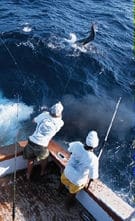
It’s like Palm Beach in the 1950s, and to score here you’ve got to hook your own fish|
“We use a big fly with big hooks,” Anthony explained. “I like the 6/0 Owners rigged in a Cam Sigler double tube fly with two hooks. It gives the fish a better target. Also, we file our hooks to make the points very, very thin, so they penetrate easily.”
Anthony likes very stiff fly rods, which make it easier to drive the hook home. An 18-weight is not too big, according to Anthony. The big rods let the angler set the hook firmly and get the fish in quickly.
Anthony pulls two hookless ballyhoo teasers, and the mate attempts to tease the fish as close as possible to the transom. “We want the fish within three or four meters of the boat so that the angler can present the fly with only one false cast, or even a roll cast,” he said.
Great sailfishing is only part of what makes Isla special, though. During our visit, we took side trips to the Mayan ruins at Chichen Itza, and swam in a giant underground spring nearby. There are great beaches (and Buho’s, one of the best beach bars in the world), beautiful snorkeling spots, lively nightclubs, great hotels, and the aforementioned great restaurants. And if Isla itself gets too quiet for you, it’s a brief ferry ride to Cancun, where the nightlife is legendary.
It’s a complete package, with something for everyone in the family. As a side benefit, Isla may hone your fishing skills. I like live bait as much as the next guy, but I freely admit that it’s a lot more fun the Isla way. It’s a great feeling when you have mastered the dropback, and you hook one fish after another as they rise to the dredge and then the bait. It’s a real feeling of accomplishment, and makes the ride back to the dock, enjoying a beautiful Mexican sunset and a cold cerveza, all the more wonderful. It’s a combination that’s hard to beat.
| Getting to Isla MujeresAnother wonderful thing about Isla is that it’s easy to get to. Simply catch a flight to Cancun, hop a taxi to the ferry dock at Puerto Juarez, and a modern, air-conditioned ferry boat whisks you across the bay to the island.We stayed at the beautiful new Hotel Playa la Media Luna (Half-Moon Beach Hotel), situated within walking distance of the docks on Isla’s eastern shore. The hotel has 18 rooms, all overlooking the ocean, and is owned and operated by Anthony Mendillo’s in-laws. Anthony operates two charter boats, the 29-foot Keen M and the 36-foot Lilly M. Both are custom, single-diesel, fully equipped sportfishermen. Anthony charters the Lilly M in Isla from the middle of February to the end of May, and the Keen M during the months of March and April, plus the first week of May.You can expect excellent sailfish action throughout this time frame, but in the latter part of the season there are many bonus species, too. White marlin mix with the sails in May, and the dolphin fishing is world-class. Plus, Anthony has developed an outstanding fishery for large grouper. The seas are generally calmer as the season progresses, too. You can book days with Anthony and rooms at the Playa la Media Luna at the numbers below.Capt. Anthony Mendillo, Jr. Florida: (561) 694-0594 Mexico: ph. 52 (9) 877-0759, fax 52 (9) 877-1124 Fishkinm@cancun.rce.com.mxHotel Playa la Media Luna Seccion Rocas, Lotes 9/10, Punta Norte Isla Mujeres, Q. Roo, 77400, Mexico U.S.: (800) 223-5695 Mexico: ph. 52 (9) 877-0759 fax 52 (9) 877-1124 www.cabanasdelmar.com |






